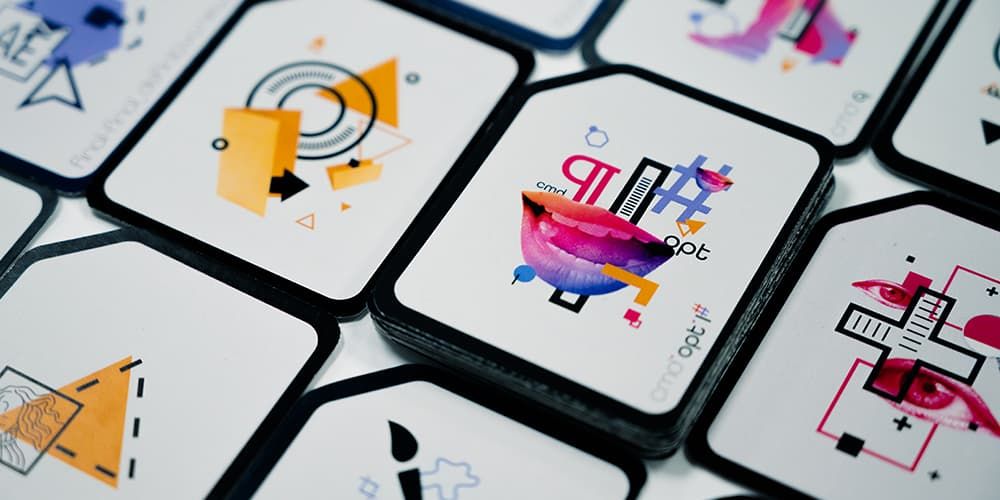BA Graphic Design
BA Graphic Design

Study Graphic Design
The continuous technological evolution and new media have created an enormous field of action for graphic designers. We live in a society with a high demand and consumption of graphic and visual communication, so if you want to be part of this world, studying graphic design is the right decision.
At ESADA you can study the Official Degree in Graphic Design, a qualification awarded by the Regional Ministry of Education and equivalent to a university degree for all purposes. These studies are part of the European Higher Education Area (EHEA) and are therefore valid internationally.
Our innovative Project Based Learning (PBL) methodology aims to produce professionals with a critical and analytical mindset, capable of developing a project from start to finish, of working in teams fluently and of defending their ideas and creations through the public exhibition of their proposals. We want learning to be meaningful and for our students to be able to manage their knowledge in an autonomous and professional manner, for which the integrated project is a fundamental tool, bringing together all the subjects in a common goal.

The projects are designed to enable students to progressively acquire all the skills necessary for the graphic design profession.
We integrate lectures by renowned professionals in the sector and organisations representing the cultural and commercial sector into our training at ESADA, bringing us closer to the real world of design.
Graphic Design offers us in each project the opportunity to do something new, to define identities, to transmit sensations through colour, form or typography, ...to communicate an idea, a thought or a feeling.
Graphic Design Syllabus
1º Course
-
Creativity and Project Methodology (Annual, 4 ECTS)
[1GCMPG] Development of creative thinking. Design methods and processes. Creativity strategies. Innovation and problem-solving in graphic design.
-
Expression techniques in Design (2nd Semester, 5 ECTS)
[1GTED] Exploration of materials and graphic expression tools. Illustration and collage techniques. Experimental applications in design.
-
Freehand drawing: Sketches (1st Semester, 5 ECTS)
[1GDMACB] Techniques for manual graphic representation. Expression and visual communication through drawing. Application of drawing in the conceptualisation of graphic projects.
-
History of Design: centuries XIX, XX and XXI (2nd Semester, 4 ECTS)
[1GHDSXXA] Major movements and figures in graphic design. Evolution of visual communication. Social and technological impact of design.
-
History of the arts and aesthetics (1st Semester, 4 ECTS)
[1GHAE] Evolution of art and its influence on design. Aesthetic principles in different artistic movements.
-
Photographic documentation (Annual, 5 ECTS)
[1GFDMA] Basics of digital photography. Lighting and composition techniques. Introduction to audiovisual media applied to design.
-
Representation systems (Annual, 8 ECTS)
[1GSR] Descriptive geometry applied to design. Three-dimensional representation. Perspectives and projections.
-
Typography I: Composition (1st Semester, 5 ECTS)
[1GT1C] Fundamentals of typography. Composition and readability. Typographic use in graphic design.
-
Typography II: From calligraphy to graffiti (2nd Semester, 5 ECTS)
[1GT2CG] History and evolution of typography. Influence of handwriting and urban art on typography.
-
Vectorial representation (Annual, 7 ECTS)
[1GRV] Fundamentals of digital vector drawing. Vector design software. Creation and manipulation of scalable graphics.
-
Visual Language (Annual, 8 ECTS)
[1GLV] Understanding and comprehension of design language: graphic alphabet, form, structure, colour, texture, light, graphic space, composition, interactions between art and design. Analysis of the image in expression and perception.
2º Course
-
3D construction (Annual, 5 ECTS)
[2GCT] Modelling techniques in graphic design. Packaging and product design. Three-dimensional representation in visual design.
-
Anthropometry and ergonomics (1st Semester, 4 ECTS)
[2GAE] Relationship between design and the user. Physical and psychological factors in design. Ergonomics applied to graphic design.
-
Eco-design and sustainability (2nd Semester, 4 ECTS)
[2GES] Environmental impact of design. Sustainable design strategies. Eco-friendly materials in graphic production.
-
Editorial design and layout (1st Semester, 6 ECTS)
[2GDEM] Principles of editorial design. Content composition and structuring. Digital and print layout.
-
History of graphic design (1st Semester, 4 ECTS)
[2GHDG] Evolution of graphic design. Major references and stylistic trends.
-
Material, technology and graphic production (Annual, 8 ECTS)
[2GMTPG] Knowledge of materials and printing media. Graphic production processes. Finishing techniques.
-
Scientific fundamentals applied to design (Annual, 7 ECTS)
[2GFCAD] Visual and cognitive perception. Application of scientific principles in graphic design.
-
Spanish graphich design. Andalusia (2nd Semester, 4 ECTS)
[2GDGEA] Influence and development of graphic design in Andalusia. Key figures and relevant studios.
-
Technical English (Annual, 4 ECTS)
[2GIT] Vocabulary and specific terminology for graphic design in English. Communication and documentation in the professional field.
-
Typography III. Design and management (Annual, 8 ECTS)
[2GTIDGT] Typeface creation. Typographic design software. Typeface usage and management in graphic projects.
-
Visual identity design (2nd Semester, 6 ECTS)
[2GDIV] Creation of brands and visual identity systems. Graphic elements of corporate identity. Applications and regulations.
3º Course
-
Advertising campaign (2nd Semester, 5 ECTS)
[3GCP] Visual communication strategies. Design of advertising campaigns for traditional and digital media.
-
Audio-visual Media (2nd Semester, 4 ECTS)
[3GMA] Audiovisual applications in graphic projects. Video editing and post-production.
-
Design applied to packaging (1st Semester, 5 ECTS)
[3GDAE] Creation of packaging and wrapping designs. Relationship between design and functionality.
-
Design management (Annual, 6 ECTS)
[3GGD] Management strategies in design studios. Business models and entrepreneurship in graphic design.
-
Illustration Applied to Design (Annual, 6 ECTS)
[3GIAD] Digital and traditional illustration techniques. Graphic applications of illustration in different media.
-
Motion Graphics (Annual, 8 ECTS)
[3GDGM] Graphic animation and motion design. Software and animation techniques.
-
Optional Subject 1 (1st Semester, 4 ECTS)
[3GO1] Varies according to institutional offer.
-
Optional Subject 2 (2nd Semester, 4 ECTS)
[3GO2] Varies according to institutional offer.
-
Photography Applied to Design (1st Semester, 4 ECTS)
[3GFAD] Use of photography in graphic design. Advanced photo editing techniques.
-
Theory and culture of Design (Annual, 6 ECTS)
[3GTCD] Reflection on design as a cultural discipline. The impact of design on contemporary society.
-
Web Design and Development (Annual, 8 ECTS)
[3GDDW] Digital interface design. Usability and user experience (UX/UI) principles. Basic web development.
4º Course
Final Graduate Project (2nd Semester, 12 ECTS)
-
Graphic design, innovation and business (1st Semester, 4 ECTS)
[4GDGIE] Application of design to business innovation. Branding and positioning strategies.
-
Information design (1st Semester, 4 ECTS)
[4GDI] Creation of infographics and data visualisation. Designing clear and effective information.
-
Interactive design (1st Semester, 6 ECTS)
[4GDI] Design for interactive interfaces. Applications in digital environments.
-
Introduction to animation (1st Semester, 6 ECTS)
[4GIA] Basic principles of animation. Digital animation techniques.
-
Optional (1st Semester, 8 ECTS)
[4GO3] Varies according to institutional offer.
Practicum (2nd Semester, 12 ECTS)
-
Presentation and Project Rhetoric (1st Semester, 3 ECTS)
[4GPRP] Communication strategies and project defence. Graphic and verbal presentation skills.
-
Spatial Graphics (1st Semester, 5 ECTS)
[4GGE] Design applied to signage and spatial environments. Relationship between graphic design and architecture.
Specialisation in Digital Marketing
ESADA, aware of the revolution that digital marketing is bringing about in communications and the importance this has in the professional development of our students, has developed a specialisation in this discipline that all students at our school will be able to access.
Three subjects related to Digital Marketing are offered and the aim is for students to obtain the necessary knowledge to manage their own brand or to obtain an alternative outlet in the labour market, related to these new professions in demand:
- Subject I. Fundamentals of digital marketing,
- Subject II. Advanced digital marketing,
- Subject III. Digital Marketing: Monitoring and Analysis.
Students will be able to take these subjects within the optional programme of our study plans. At the end of the course, they will receive a certificate from the centre accrediting their specialisation in Digital Marketing.
As it is a regulated education, the regulations that develop the Higher Degree in Design in the speciality of Graphic Design establish a series of Specific Competences that the students must acquire, which are:
- Generate, develop and materialise ideas, concepts and images for complex communicative programmes.
- Master the formal resources of visual expression and communication.
- Understand and use the capacity of meaning of graphic language.
- Master the procedures for the creation of communicative codes.
- Establish organisational structures of information.
- Interrelate formal and symbolic languages with specific functionality.
- Determine and, if necessary, create typographic solutions appropriate to the objectives of the project.
- Know the channels that support visual communication and use them in accordance with the communicational objectives of the project.
- Analyse the behaviour of the recipients of the communication process according to the objectives of the project.
- Apply methods for verifying the effectiveness of communication.
- Master the technological resources of visual communication.
- Master digital technology for the treatment of images, texts and sounds.
- Know the economic, social, cultural and historical context in which graphic design is developed.
- Understand the legal and regulatory framework that regulates professional activity, occupational health and safety and intellectual and industrial property.
- Reflect on the positive social influence of design, assess its impact on the improvement of the quality of life and the environment and its capacity to generate identity, innovation and quality in production.
- Corporate and visual identity.
- Editorial design.
- Graphic production.
- Packaging design.
- Art direction in advertising.
- Audiovisual design.
- Television graphics.
- Multimedia design.
- Interaction design, web design.
- Environmental designer: graphics and communications applied to space.
- Design of didactic material.
- Research and teaching.
Access to the degree
Don't forget to visit the section Requirements to find out in detail what you need to study next year at our centre.




